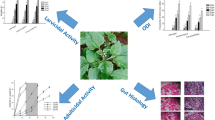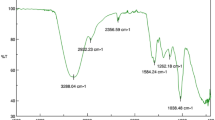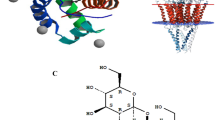Abstract
Synthetic pesticides are a considerable issue in both terrestrial and aquatic habitats. Green pesticides derived from fungi, provide an efficient tools and alternative to chemicals. Secondary metabolites from Metarhizium anisopliae were tested against major disease mosquitos such as, Anopheles stephensi, Aedes aegypti, and Culex quinquefasciatus, as well as two non-target species, Eudrilus eugeniae and Artemia nauplii. After 24 h of treatment, M. anisopliae derived chemical constituent produced low LC50 values, 54.678, 92.819, and 93.792 µg/ml on Aedes aegypti, for Anopheles stephensi, 80.933, 116.990 and 130.173 µg/ml, for Culex quinquefasciatus, 109.733, 196.540, 182.853 µg/ml in larvae, pupae, and adult, respectively. On the contrary, fungal metabolites are not hazardous to non-target species.. Midgut histology investigations revealed that M. anisopliae metabolites were less harmful to earthworms than chemical pesticides (Permethrin). The treatment of fungal crude extract exhibited minimal toxicity effects on gut tissues, normal epidermis, circular muscle, setae, mitochondrion, and intestinal lumen tissues. M. anisopliae crude metabolites showed a lower toxicity against the non-target species A. nauplii. Our results clearly shows minimal mortality rates were produced by the M. anisopliae derived chemical constituents, LC50 and LC90 values were, 455.947, 5098.233 μg/mL−1. No behavioral changes were observed during the treatment. The primary components of M.anisopliae crude extract identified by GC–MS studies were aucubin (14.356%) and 9, 12-Octadecadienoic acid (z,z)-(75.009%). The presence of key functional groups such as carboxylic acid, amides, and phenol groups was revealed by FT-IR spectral studies, which may be involved in mosquitocidal activity.





Similar content being viewed by others
References
Abbott WS (1925) A method for computing the effectiveness of an insecticide. J Econ Entomol 18:265–267
Amer A, Mehlhorn H (2006) Repellency effect of forty-one essential oils against Aedes, Anopheles, and Culex mosquitoes. Parasitol Res, 99(4), 478–490. and Metarhizium anisopliae in temperate agroecosystems: potential for conservation
Balumahendhiran K, Vivekanandhan P, Shivakumar MS (2019) Mosquito control potential of secondary metabolites isolated from Aspergillus flavus and Aspergillus fumigatus. Bio Agri Biotechnol, 21, 101334. biological control. Bio Control 43:145–155
Cuervo-Parra JA, Cortés TR, Ramirez-Lepe M (2016) Mosquito-borne diseases, pesticides used for mosquito control, and development of resistance to insecticides. Ins Res. Rijeka: In Tech Open 111–34
Ehrlich KC, Chang PK, Scharfenstein LL, Cary JW, Crawford JW (2010) Absence of the aflatoxin biosynthesis gene, norA, allows accumulation of deoxyaflatoxin B1 in Aspergillus flavus cultures. FEMS (Fed. Eur. Microbiol. Soc.) Microbiol. Lett 305:65–70
Ganesan P, Stalin A, Paulraj MG, Balakrishna K, Ignacimuthu S, Al-Dhabie NA (2018) Biocontrol and non-target effect of fractions and compound isolated from Streptomyces rimosus on the immature stages of filarial vector Culex quinquefasciatus Say (Diptera: Culicidae) and the compound interaction with Acetylcholinesterase (AChE1). Ecotoxicol Environ Saf 161:120–128
GBD (2015) Disease and Injury Incidence and Prevalence, Collaborators, Lancet, London, England 388(10053), (2016):1545–1602
Guideline for Evaluating Insecticide Resistance in Vectors Using the CDC Bottle Bioassay (2016). https://www.cdc.gov/malaria/resources/pdf/fsp/ir_manual/ir_cdc_bioassay_en.pdf
Hansen IA, Marcombe S, Mathieu RB, Pocquet N, Riaz MA, Poupardin R, Sélior S, Darriet F, Reynaud S, Yébakima A, Corbel V, David JP, Chandre F (2012) Insecticide resistance in dengue vector Aedes aegypti from Martinique: Distribution, mechanisms and relations with environmental factors. PLoS ONE 7:30989
Jegathambigai RN, Rusli I, Sreenivasan S (2014) Acute Oral Toxicity and Brine Shrimp Lethality of Methanol Extract of Mentha Spicata L (Lamiaceae). Trop J Pharm Res J 13:101–107
Jeger MJ, Madden LV, Van den Bosch F (2009) The effect of transmission route on plant virus epidemic development and disease control. J Theor Biol 258(2):198–207
Kalaimurugan D, Vivekanandhan P, Sivasankar P, Durairaj K, Senthilkumar P, Shivakumar MS, Venkatesan S (2019) Larvicidal activity of silver nanoparticles synthesized by Pseudomonas fluorescens YPS3 isolated from the Eastern Ghats of India. J Clust Sci 30(1):225–233
Katagi T, Tanaka H (2016) Metabolism, bioaccumulation, and toxicity of pesticides in aquatic insect larvae. J Pestic Sci 41 25–37
Larson SR, Degroot JP, Bartholomay LC, Sugumaran R (2010) Ecological niche modeling of potential West Nile virus vector mosquito species in Iowa. J Ins Sci 10(1):110
Logeswaran C, Vivekanandhan P, Shivakumar MS (2019) Chemical constituents of thermal stress induced Ganoderma applantum (Per.) secondary metabolites on larvae of Anopheles stephensi, Aedes aegypti and Culex quinquefasciatus and histopathological effects in mosquito larvae. Bio Agri Biotech 20:101253
Manilal A, Sujith S, Kiran GS, Selvin J, Shakir C, Gandhimathi R, Panikkar MVN (2009) Biopotentials of seaweeds collected from southwest coast of India. J Mar Sci Technol 17(1):67–73
Matha V, Weiser JA, Olejricek J (1988) The effect of tolypin on Tolypocladium niveum crude extract against mosquito and black fly larvae in laboratory. Folia Parasitol 35:379–381
Meyling NV, Eilenberg J (2007) Ecology of the entomopathogenic fungi Beauveria bassiana
Milam CD, Farris JL, Wilhide JD (2000) Evaluating mosquito control pesticides for effect on target and nontarget organisms. Arch Env Contam Toxicol 39:324–328
Mohanty SS, Prakash S (2004) Extracellular metabolites of Trichophytonajelloi against Anopheles stephensi and Culex quinquefasciatus larvae. Curr Sci 86:323–325
N’Guessan R, Asidi A, Boko P, Odjo A, Akogbeto M, Pigeon O, Rowland M (2010) An experimental hut evaluation of PermaNet® 3.0, a deltamethrin piperonyl butoxide combination net, against pyrethroid-resistant Anopheles gambiae and Culex quinquefasciatus mosquitoes in southern Benin. Trans R Soc Trop Med Hyg 104(12):758–765
Paschapur A, Subbanna ARNS, Singh AK, Jeevan B, Stanley J, Rajashekhar H, Mishra KK (2021) Unraveling the importance of metabolites from entomopathogenic fungi in insect pest management. In Microbes for Sustainable lnsect Pest Management. Springer, Cham, pp 89–120
Pittarate S, Rajula J, Rahman A, Vivekanandhan P, Thungrabeab M, Mekchay S, Krutmuang P (2021) Insecticidal effect of zinc oxide nanoparticles against Spodoptera frugiperda under laboratory conditions. Insects 12(11):1017
Prakash S, Singh G, Soni N, Sharma S (2010) Pathogenicity of Fusariumoxysporum against the larvae of Culexquinquefasciatus (Say) and Anopheles stephensi (Liston) in laboratory. Parasitol Res 1911–1921
Priyanka SJN, Prakash S (2001) Chrysosporium tropicum efficacy against Anopheles stephensi larvae in the laboratory. J Am Mosq Con Ass 17:127–130
Ragavendran C, Mariappan T, Natarajan D (2017) Larvicidal, Histopathological Efficacy of Penicillium daleae against Larvae of Culex quinquefasciatus and Aedes aegypti Plus Biotoxicity on Artemia nauplii a Non-target Aquatic Organism. Front Pharmacol. https://doi.org/10.3389/fphar.2017.00773
Ravindran K, Akutse KS, Sivaramakrishnan S, Wang L (2016) Determination and characterization of destruxin production in Metarhizium anisopliae Tk6 and formulations for Aedes aegypti mosquitoes control at the field level. Toxicon 120:89–96
Scholte EJ, Takken W, Knols BGJ (2007) Infection of adult Ae. aegypti and An. albopictus mosquitoes with the entomopathogenic fungus Metarhizium anisopliae. Acta Trop 102:151–158
Siddhardha B, Murty USN, Narasimhulu M, Venkateswarlu Y (2010) Isolation, Characterization and Biological evaluation of secondary metabolite from Aspergillus funiculosus. Ind J Microbio 50(2):225–228
Singh G, Prakash S (2010) Fungi Beauveria bassiana (Balsamo) metabolites for controlling malaria and Filaria in Tropical Countries. Adv Biomed Res ISBN: 978–960–474–164–9 Cambridge Press
Singh G, Prakash S (2012) Evaluation of culture filtrates of Culicinomyces clavisporus: myco Adulticide for Culex quinquefasciatus, Aedes aegypti and Anopheles stephensi. Parasitol Res 110:267–272
Skrobek A, Butt TM (2005) Toxicity testing of destruxins and crude extracts from the insect-pathogenic fungus Metarhizium anisopliae. FEMS Microbiol Lett 251(1):23–28
Soni N, Prakash S (2010) Effect of Chrysosporium keratinophilum metabolites against Culexquinquefasciatus after chromatographic purification. Parasitol Res 107:1329–1336
Sriwattanarungsee S, Sukontason KL, Olson JK, Chailapakul O, Sukontason K (2008) Efficacy of neem extract against the blowfly and housefly. Parasitol Res 103:535–544
Strasser H, Vey A, Butt TM (2000) Are there any risks in using entomopathogenic fungi for pest control, with particular reference to the bioactive metabolites of Metarhizium, Tolypocladium and Beauveria species? Biocontrol Sci Technol 10(6):717–735
Varó I, Serrano R, Navarro JC, López FJ, Amat F (1998) Acute lethal toxicity of the organophosphorus pesticide chlorpyrifos to different species and strains of Artemia. Bullet Environ Contam Toxic 61(6):778–785
Vijayan V, Balaraman K (1991) Metabolites of fungi & actinomycetes active against mosquito larvae. Ind J Med Res 93:115–117
Vilcinskas A, Matha V, Götz P (1997) Effects of the entomopathogenic fungus Metarhizium anisopliae and its secondary metabolites on morphology and cytoskeleton of plasmatocytes isolated from the greater wax moth. Galleria Mellonella J Insect Physiol 43(12):1149–1159
Vivekanandhan P, Deepa S, Kweka EJ, Shivakumar MS (2018a) Toxicity of Fusarium oxysporum-VKFO-01 Derived Silver Nanoparticles as Potential Inseciticide Against Three Mosquito Vector Species (Diptera: Culicidae). J Clust Sci. https://doi.org/10.1007/s10876-018-1423-1
Vivekanandhan P, Karthi S, Shivakumar MS, Benelli G (2018b) Synergistic effect of entomopathogenic fungus Fusarium oxysporum extract in combination with temephos against three major mosquito vectors. J Pathol Global Health. https://doi.org/10.1080/20477724.2018.1438228
Vivekanandhan P, Kavitha T, Karthi S, Senthil-Nathan S, Shivakumar MS (2018c) Toxicity of Beauveria bassiana-28 Mycelial Extracts on Larvae of Culex quinquefasciatus Mosquito (Diptera: Culicidae). Int J En Res Pub Health 15:440. https://doi.org/10.3390/ijerph15030440
Vivekanandhan P, Senthil-Nathan S, Shivakumar MS (2018d) Larvicidal, pupicidal and adult smoke toxic effects of Acanthospermum hispidum (DC) leaf crude extracts against mosquito vectors. Phy Mol Plant Pathol 101:156–162
Vivekanandhan P, Usha-Raja-Nanthini A, Valli G, Shivakumar MS (2018e) Comparative efficacy of Eucalyptus globulus (Labill) hydrodistilled essential oil and temephos as mosquito larvicide. Nat Prod Res. https://doi.org/10.1080/14786419.2018.1547290
Vivekanandhan P, Venkatesan R, Ramkumar G, Karthi S, Senthil-Nathan S, Shivakumar MS (2018f) Comparative Analysis of Major Mosquito Vectors Response to Seed-Derived Essential Oil and Seed Pod-Derived Extract from Acacia nilotica. Int J Env Res Pub Health 15:388
Vivekanandhan P, Swathy K, Kalaimurugan D, Ramachandran M, Yuvaraj A, Kumar AN, Manikandan AT, Poovarasan N, Shivakumar MS, Kweka EJ (2020a) Larvicidal toxicity of Metarhizium anisopliae metabolites against three mosquito species and non-targeting organisms. PLoS ONE 15(5):0232172
Vivekanandhan P, Bedini S, Shivakumar MS (2020b) Isolation and identification of entomopathogenic fungus from Eastern Ghats of South Indian forest soil and their efficacy as biopesticide for mosquito control. Parasitol Int 76:102099
Vivekanandhan P, Thendralmanikandan A, Kweka EJ, Mahande AM (2021a) Resistance to temephos in Anopheles stephensi larvae is associated with increased cytochrome P450 and α-esterase genes overexpression. Int J Trop Ins Sci 1–6
Vivekanandhan P, Swathy K, Thomas A, Kweka EJ, Rahman A, Pittarate S, Krutmuang P (2021b) Insecticidal Efficacy of Microbial-Mediated Synthesized Copper Nano-Pesticide against Insect Pests and Non-Target Organisms. Inl J Environ Res Pub Health 18(19):10536
Vivekanandhan P, Swathy K, Shivakumar MS (2022a) Stability of insecticidal molecule aucubin and their toxicity on Anopheles stephensi, Aedes aegypti, Culex quinquefasciatus and Artemia salina. Int J Trop Insect Sci 1–15
Vivekanandhan P, Swathy K, Shivakumar MS (2022b) Identification of insecticidal molecule aucubin from Metarhizium anisopliae ethyl acetate crude extract against disease mosquito vector. Int J Trop Insect Sci 1–16
Vivekanandhan P, Swathy K, Murugan AC, Krutmuang P (2022c) Insecticidal efficacy of Metarhizium anisopliae derived chemical constituents against disease-vector mosquitoes. J Fungi 8(3):300
Vyas N, Dua KK, Prakash S (2006) Larvicidal Activity of Metabolites of Metarhizium anisopliae against Aedes and Culex Mosquitoes. Entomol Ornithol Herpetol 4:4
Vyas N, Dua KK, Prakash S (2007) Efficacy of Lagenidium giganteum metabolites on mosquito larvae with reference to non target organisms. Parasitol Res 101:385–390
World Health Organization (2005) Guidelines for Laboratory and Field Testing of Mosquito Larvicides. Communicable Disease Control, Prevention and Eradication; WHO, Pesticide Evaluation Scheme; WHO: Geneva, Switzerland 1–219
Zhang L, Fasoyin OE, Molnár I, Xu Y (2020) Secondary metabolites from hypocrealean entomopathogenic fungi: Novel bioactive compounds. Nat Prod Rep 37(9):1181–1206
Acknowledgements
P.Vivekanandhan thank for providing financial supports under University Research Fellowship Scheme (Ref No. PU/AD-3/URF/2016) to Periyar University. We also thank the Institute of Vector Control and Zoonoses (IVCZ) Hosur for supplying eggs. We also express our thanks to Department of Biotechnology, Periyar University, Salem, for providing infrastructural facility for carry out our research successfully.
Author information
Authors and Affiliations
Contributions
P. Vivekanandhan designed the research; P. Vivekanandhan done the experiments and interpreted the data and wrote the manuscript; M.S. Shivakumar and S. Bedini and K. Swathy revised and approved the final draft.
Corresponding author
Ethics declarations
Ethical statement
The present research does not have any evaluation/test in humans performed by any of the authors contains this article. We followed all national, international guidelines for use of target and non-target organisms were followed.
Conflicts of interest
The authors declare that they do not have any conflict of interest.
Additional information
Publisher's Note
Springer Nature remains neutral with regard to jurisdictional claims in published maps and institutional affiliations.
Supplementary Information
Below is the link to the electronic supplementary material.
Rights and permissions
Springer Nature or its licensor (e.g. a society or other partner) holds exclusive rights to this article under a publishing agreement with the author(s) or other rightsholder(s); author self-archiving of the accepted manuscript version of this article is solely governed by the terms of such publishing agreement and applicable law.
About this article
Cite this article
Vivekanandhan, P., Swathy, K., Bedini, S. et al. Bioprospecting of Metarhizium anisopliae derived crude extract: a ecofriendly insecticide against insect pest. Int J Trop Insect Sci 43, 429–440 (2023). https://doi.org/10.1007/s42690-022-00935-y
Received:
Accepted:
Published:
Issue Date:
DOI: https://doi.org/10.1007/s42690-022-00935-y




